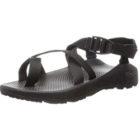Beaches – Both the beaches of the Zanzibar archipelago and those along on the coast of mainland Tanzania have soft white sands and clear turquoise waters that will please even the pickiest beach-goer. At the touristy beaches, including any on Zanzibar, women can feel comfortable wearing bikinis, although opting for a style with more coverage is more respectful.
At beaches that are far from the tourist trail, local people will be more conservative and less accustomed to swimwear-clad foreigners; in that case, I’d recommend wearing a modest one-piece suit and covering up when you’re out of the water unless the beach is totally deserted (and many are!). Men can wear either briefs or swim trunks at any beach but do put on a shirt once you’re off the sand. The standard beach footwear for Tanzania is flip-flops, of course. But if you’re planning on doing anything more active in the water, a pair of water shoes or sturdier sandals is a good idea.
Trekking – Tanzania is renowned for its trekking; after all, Mt. Kilimanjaro is the tallest mountain in Africa and the highest free-standing mountain in the world. But if you don’t have the time or funds for the week-long climb, there are plenty of other trekking options, including day hikes that are suitable for all levels. In general, you should plan to have three layers: a sweat-wicking base layer (like a fitted merino wool t-shirt), an insulated mid-layer (like a fleece jacket), and a wind- and waterproof outer layer (like a rain jacket). Layering will make it easy to stay comfortable throughout the day, as the temperatures change or you work up a sweat hiking.
Layers are less important on the bottom, and in warmer conditions, a pair of hiking pants is sufficient. But for higher elevations and colder climates, including Mt. Kilimanjaro and Mt. Meru, bring a pair of leggings or long underwear to wear beneath your pants. For those treks, you’ll also need a hat and a pair of gloves to stay warm. While you can get away with wearing tennis shoes for easy day hikes, waterproof hiking boots are a necessity for Tanzania’s longer and more strenuous treks – just make sure you break them in before your trip. For multi-day hikes, you’ll probably also appreciate having another pair of comfortable shoes to change into at night.
Safaris – For many visitors, the chance to go on a safari is Tanzania’s main attraction. But since it’s such an unusual experience, most will question what to wear for such an occasion. Most of your time will be spent sitting in a vehicle, taking easy walks, or hanging out at a lodge – honestly, I’ve really never seen a need for the tactical-looking vests and cargo pants usually marketed as African safari clothes. That said, it’s a good idea to dress in neutral colors, which will help you blend into your surroundings and cause less disturbance to the wildlife. The best safari clothing for Tanzania will depend on the time of year, but bringing items that will easily layer is always the best way to stay comfortable.
For the most part, Tanzania’s safari destinations are hot during the day, so tops and pants made from lightweight fabrics will be the most comfortable. Since you’ll likely spend a lot of time in the sun, a hat and sunglasses are also a good idea. In addition to a lightweight safari outfit, I’d suggest bringing a fleece jacket, as well as a pair of heavier pants (or a base layer to wear under thinner pants), as it can get cold in the morning in open-air vehicles. Lastly, closed-toed shoes will be best for keeping your toes warm during chilly game drives, and a pair of sturdy sandals will be convenient for walking around camp.









































































